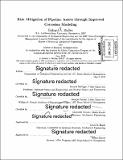Risk mitigation of pipeline assets through improved corrosion modeling
Author(s)
Mullen, Richard A. (Richard Almond)
DownloadFull printable version (6.874Mb)
Other Contributors
Leaders for Global Operations Program.
Advisor
Georgia Perakis and Alexander Slocum.
Terms of use
Metadata
Show full item recordAbstract
Infrastructure has to weather the elements and still function. Gas transmission and distribution piping at a utility are no exception. Atmospheric corrosion deteriorates the integrity of the natural gas system, and utilities need to respond with countermeasures in order to mitigate the risk. The ability to predict where atmospheric corrosion will cause leaks will allow for a better allocation of resources in mitigating the risk caused by corrosion. First a corrosion simulation model was developed to predict the number of leaks in each geographic area in PG&E's service area. Past meteorological data, past pollution data, 2014 atmospheric corrosion inspections on 2.27 million meters, leak data, and gas system asset information (meter age, type, etc.) were used. The qualitative observations and a quantitative model were then coupled in a simulation model to predict the number of leaks depending on the years between atmospheric corrosion inspections. Utilizing the output of the corrosion prediction model, an optimization model was developed to determine the atmospheric corrosion inspection frequency that will minimize the risk of leaks to the system. This model will allow PG&E to understand how reallocating inspection resources can reduce risk of leaks. The overall results indicate that data quality plays a very important role in coupling qualitative observations with a quantitative model. From the model developed and analyzed in this thesis, several opportunities for better data collection were identified. By collecting targeted data on localized corrosion and corrosion rates, qualitative inspections can contribute greatly to accurately model corrosion where quantitative models are lacking.
Description
Thesis: M.B.A., Massachusetts Institute of Technology, Sloan School of Management, 2015. In conjunction with the Leaders for Global Operations Program at MIT. Thesis: S.M., Massachusetts Institute of Technology, Department of Mechanical Engineering, 2015. In conjunction with the Leaders for Global Operations Program at MIT. Cataloged from PDF version of thesis. Includes bibliographical references (pages 69-71).
Date issued
2015Department
Leaders for Global Operations Program at MIT; Massachusetts Institute of Technology. Department of Mechanical Engineering; Sloan School of ManagementPublisher
Massachusetts Institute of Technology
Keywords
Sloan School of Management., Mechanical Engineering., Leaders for Global Operations Program.